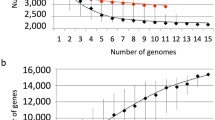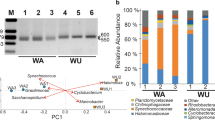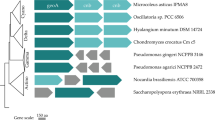Abstract
Cyanobacteria are oxygenic photosynthetic organisms which are found across many ecosystems, including freshwater and marine habitats. They are also found on natural and artificial surfaces. In this study, we cultured and characterise a novel cyanobacterium from the surfaces of foam microplastics of tropical coastal waters. We study the chemical ecology of this cyanobacterium, Sphaerothrix gracilis gen. et sp. nov., together with its potential to form harmful cyanobacterial blooms and bioremediation applications to combat plastic pollution. The genome of S. gracilis spanned 6.7 Mbp, with identification of antibiotic resistance, nitrogen-fixation, plastic-degrading and genes involved in harmful metabolite production. The transport of potentially harmful S. gracilis in coastal environments could have severe implications on human health and food security, especially in times of a cyanobacterial bloom.

Similar content being viewed by others
Data availability
The draft genome sequence of Sphaerothrix gracilis was deposited in Genbank, NCBI Whole Genome Shotgun project: SUB13190905, under BioProject PRJNA964492 and BioSample accession number SAMN34473616.
References
Barone GD, Ferizović D, Biundo A, Lindblad P (2020) Hints at the Applicability of Microalgae and Cyanobacteria for the Biodegradation of Plastics. Sustainability 12(24):10449
Blin K, Shaw S, Kloosterman AM, Charlop-Powers Z, Van Wezel GP, Medema MH, Weber T (2021) antiSMASH 6.0: improving cluster detection and comparison capabilities. Nucleic Acids Res 49(W1):W29–35
Curren E, Leong SC (2020) Natural and anthropogenic dispersal of cyanobacteria: a review. Hydrobiologia 847(13):2801–2822
Gambarini V, Pantos O, Kingsbury JM, Weaver L, Handley KM, Lear G (2022) PlasticDB: a database of microorganisms and proteins linked to plastic biodegradation. Database 2022:baac008
Gopalakrishnan KK, Kashian DR (2023) Complex interactions among temperature, microplastics and cyanobacteria may facilitate cyanobacteria proliferation and microplastic deposition. Ecotoxicol Environ Saf 263:115259
Hájek J, Bieringer S, Voráčová K, Macho M, Saurav K, Delawská K, Divoká P, Fišer R, Mikušová G, Cheel J, Fewer DP (2021) Semi-synthetic puwainaphycin/minutissamide cyclic lipopeptides with improved antifungal activity and limited cytotoxicity. RSC Adv 11(49):30873–30886
Hanington P, Rose A, Johnstone R (2016) The potential of benthic iron and phosphorus fluxes to support the growth of a bloom forming toxic cyanobacterium Lyngbya majuscula, Moreton Bay, Australia. Mar Freshw Res 67(12):1918–1927
Kajitani R, Toshimoto K, Noguchi H, Toyoda A, Ogura Y, Okuno M, Yabana M, Harada M, Nagayasu E, Maruyama H, Kohara Y (2014) Efficient de novo assembly of highly heterozygous genomes from whole-genome shotgun short reads. Genome Res 24(8):1384–1395
Sathicq MB, Sabatino R, Corno G, Di Cesare A (2021) Are microplastic particles a hotspot for the spread and the persistence of antibiotic resistance in aquatic systems? Environ Pollut 279:116896
Wang Z, Chen Q, Zhang J, Guan T, Chen Y, Shi W (2020) Critical roles of cyanobacteria as reservoir and source for antibiotic resistance genes. Environ Int 144:106034
Acknowledgements
This work was partially supported by funds awarded to Dr Sandric Leong through the National University of Singapore, the National Conservation Trust Fund for Natural Resources (NCTF) LPS2203 awarded to Dr Teruaki Yoshida and Grant-in-Aid for Scientific Research Grant # 21K1094 awarded to Dr Victor Kuwahara. The help from members of Team HABs, Nikon Imaging Center, Singapore Bioimaging Consortium, St. John’s Island National Marine Laboratory, Soka University, Japan and University Malaysia Sabah also greatly supported this project.
Funding
This work was partially supported by funds awarded to Dr Sandric Leong through the National University of Singapore, the National Conservation Trust Fund for Natural Resources (NCTF) LPS2203 awarded to Dr Teruaki Yoshida and Grant-in-Aid for Scientific Research Grant # 21K1094 awarded to Dr Victor Kuwahara.
Author information
Authors and Affiliations
Contributions
All authors contributed to this work equally. Cyanobacteria samples were obtained and processed by E.C. Methodology, analysis and investigation was carried out by all authors. Review and editing was conducted by E. C and S.L. Supervision was carried out by V. K., T. Y. and S. L.
Corresponding author
Ethics declarations
Ethical approval
Not applicable.
Competing interests
The authors declare no competing interests.
Additional information
Publisher’s Note
Springer Nature remains neutral with regard to jurisdictional claims in published maps and institutional affiliations.
Electronic supplementary material
Below is the link to the electronic supplementary material.
Rights and permissions
Springer Nature or its licensor (e.g. a society or other partner) holds exclusive rights to this article under a publishing agreement with the author(s) or other rightsholder(s); author self-archiving of the accepted manuscript version of this article is solely governed by the terms of such publishing agreement and applicable law.
About this article
Cite this article
Curren, E., Kuwahara, V.S., Yoshida, T. et al. Draft genome of novel cyanobacteria Sphaerothrix Gracilis isolated from coastal microplastics reveal insights to chemical ecology, bloom and plastic-utilization potential. Funct Integr Genomics 24, 46 (2024). https://doi.org/10.1007/s10142-024-01328-9
Received:
Revised:
Accepted:
Published:
DOI: https://doi.org/10.1007/s10142-024-01328-9




